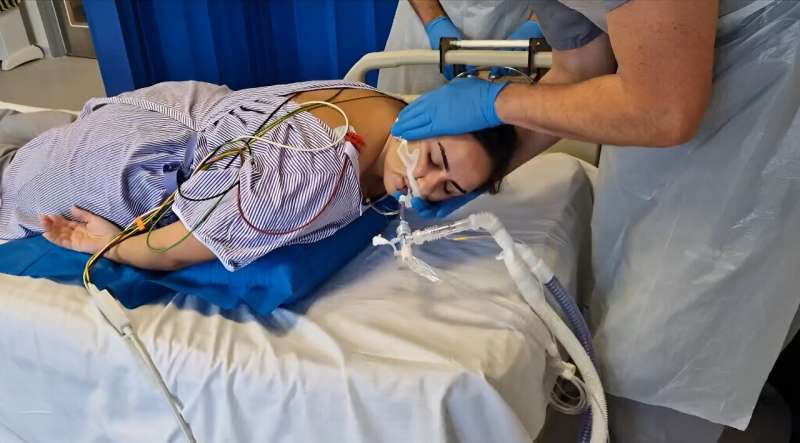This article has been reviewed according to Science X's editorial process and policies. Editors have highlighted the following attributes while ensuring the content's credibility:
fact-checked
trusted source
proofread
Inflatable cushion designed to help health care staff move patients to enter clinical trial

An inflatable device created to help doctors and nurses safely move critically ill patients is set to enter clinical trials at the Royal United Hospitals Bath NHS Foundation Trust (the RUH).
Designed by engineers at the University of Bath in collaboration with doctors at the RUH, the Inflatable Prone Repositioning Device (IPRD), known as the "BathMat," is a flat balloon-like cushion made to assist health care staff move the most critically ill patients on the intensive care unit.
The project has now received funding to determine the effectiveness of the device and to explore its commercial potential.
Critically ill patients on the intensive care unit who are sedated and on a ventilator with severe lung injury, can benefit from being placed on their front. This can increase the oxygen levels in their blood and reduces their risk of death by up to 17%.
A seven-person task, now possible by two
To avoid painful bed sores and injuries to other parts of the body, national guidelines require these patients to be repositioned every two to four hours. This is a complicated, manual task that requires up to seven staff to lift and carefully reposition the patient's arms and head.
Great care must be taken not to displace the tubes and drips which are keeping the patient alive. Currently, this is done using sliding sheets or hoists, with repositioning accounting for more than half a million staff hours per year in the NHS.
The researchers behind the device say they hope it will make it possible for just two staff to complete the process, and cut the time needed from over half an hour per position adjustment to less than 10 minutes. While substantially improving the safety of the procedure for patients, and releasing staff to perform other care duties, it also has the potential to reduce the risk of manual handling injuries for staff.
Dr. Alexander Lunt, a Senior Lecturer in the Department for Mechanical Engineering and Co-director of the Center for Integrated Materials, Processes & Structures (IMPS), is the University of Bath lead. He says, "Our goal is that the device will be proven to maintain or improve safety standards and enhance patient outcomes in the most unwell patients. We aim to achieve this while saving time and reducing the number of clinicians required needed to reposition prone patients."
16,500 patients a year
Currently, 16,500 patients are cared for in this way in the NHS each year. A device such as the IPRD could reduce the likelihood of pressure sores and organ injury, potentially allowing for more frequent repositioning. The device could bring knock-on benefits such as freeing up staff to perform other duties and protecting staff-to-patient ratios.
The initial inspiration for the device came from Dr. Jerome Condry, Anesthetics Clinical Fellow at the RUH who has extensive first-hand experience of the challenges of regular patient repositioning, and is clinical lead on the project.
Dr. Condry added, "Being able to reduce the time, or the number of staff needed to complete the process has substantial potential to make patients safer. The device has been carefully developed as a close collaboration over the past two years. We have received regular feedback from clinicians and patients alike, being described as a game changer and no-brainer by independent reviewers."
Dr. Lunt continued, "This project was founded on the collaborative connections that we established during the COVID 19 pandemic. During this period we gained first-hand insights into the challenging medical environment our clinicians work in. Intensive care units are very advanced, dynamic places, but we were keen to see where we could lend our engineering expertise to further help the clinical staff, and ultimately their patients.
"The number of people who need to be put in the prone position is thankfully low, but we saw the potential to make the process simpler. It's a complex task and the need to carry it out safely while avoiding injury or snagging tubes and pieces of equipment means it is very resource intensive."
Dr. Andy Georgiou is a consultant in Anesthesia and Intensive Care Medicine at the RUH and has been the consultant lead for the project since the outset. He says, "Turning some patients who are sedated and on a ventilator onto their front is life-saving. Caring for these patients while on their front is challenging but vital to avoid causing the patient serious injury.
"This device has three main benefits: improving safety for our sickest patients, releasing staff to care for other critically ill patients and reducing the risk of injury to our specialist teams of staff. I look forward to the trial which will help us to better quantify these benefits."




















